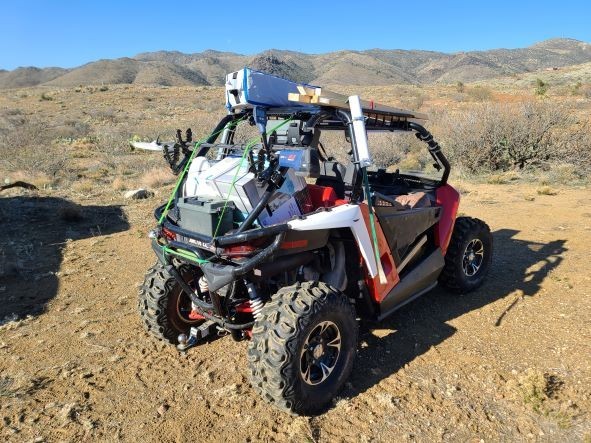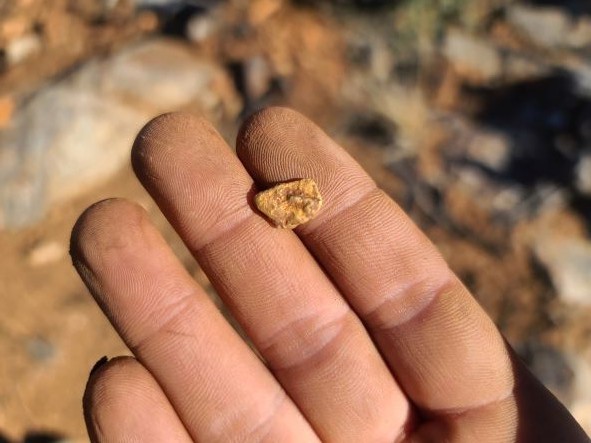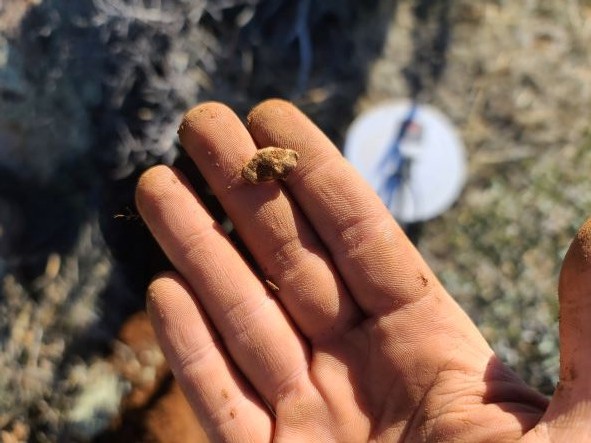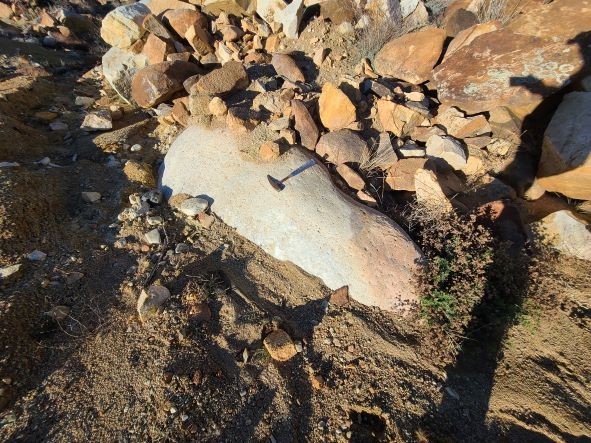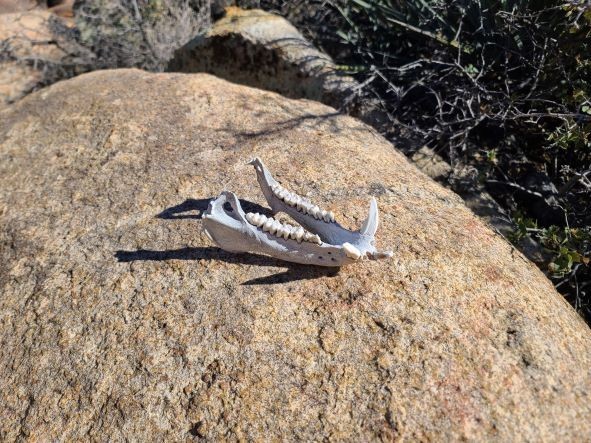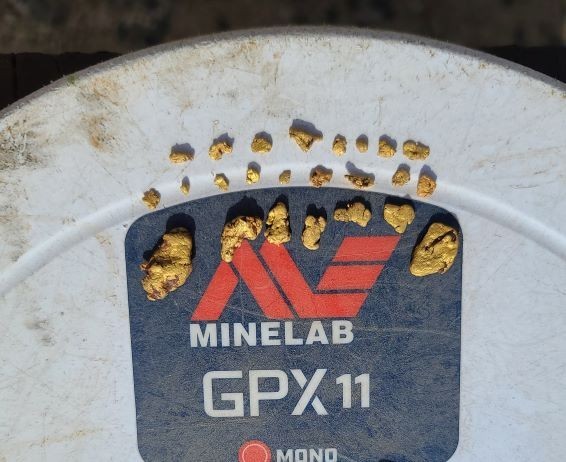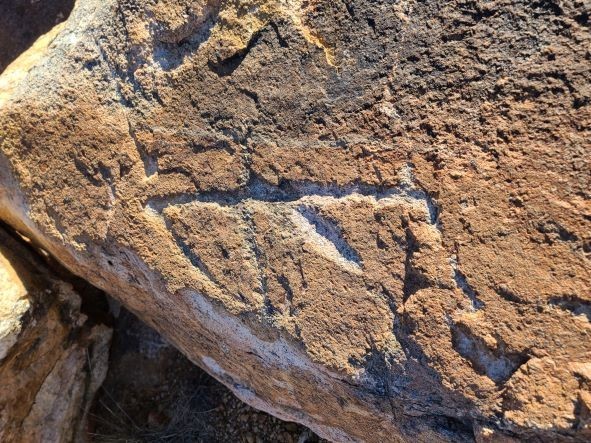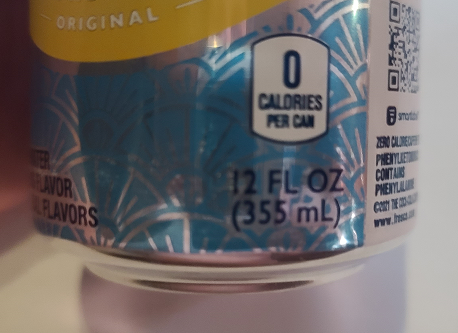-
Posts
2,468 -
Joined
-
Last visited
Content Type
Forums
Detector Prospector Home
Detector Database
Downloads
Everything posted by jasong
-

7 Days Of Arizona Detecting With The 6000
jasong replied to jasong's topic in Detector Prospector Forum
Labs usually take between 50g to 150g of material for the actual assay. I send in about 500g-1kg samples usually. I believe they crush it all and mix it, and keep it for some time in case re-assays are ordered. Or you might use some leftover do metallic screening process on samples that assay over some threshold like 5g/ton in order to not miss high value results. Sampling is usually of 2 types - grab samples or chip samples. Grab samples can assay extremely high and be unrepresentative of an ore body. This is kind of what an XRF does. Thus, it should mostly be a qualitative measurement just like XRF, even though it's an actual assay. IE - more useful just to show if something is there or not, and how high in value it could potentially run in small, selective hand picked quantities. This sampling is often just picking up some good looking pieces of ore by hand/eye. If a project is only posting flashy grab sample assays...be wary! When small scale prospectors assay material, often this is all they are doing too. Chip sampling is different. I base my method loosely off my time with field geologists on my Gold Basin project. Basically, draw a line across an area of interest and hammer off chips semi-continuously over that entire interval into the sample bag. So, you are getting an overall representation of the gangue rock, many parts of the ore zone, and even some soil or caliche if they are in cracks and fall in the bag. You can do multiple sample intervals over the same line and get much different results - for instance if your line is 20ft wide then you could do a 3ft interval over just the vein, and two 3ft intervals over each side of the wall rock, and a 20ft interval over the whole thing. So, you can have assays that end up representing any part of your zone of interest individually, or any combination of them. When doing this, it's important to ignore what you are hammering and just take it all in, the whole kit n kaboodle whatever it may be. No selective bias at all. This is important today because many projects are looking at bulk open pit mining, so if your gangue material is holding something like a consistent 0.5g/ton gold in addition to the primary vein/ore, well then it might be economically feasible today whereas it wasn't in the past. It's also similar to core sampling, where instead of spray painting a line to sample across, you are assaying different intervals of the core where the drill hole itself is your sample line. My terminology here probably isn't 100% correct, but you get the idea of the process more or less. -

7 Days Of Arizona Detecting With The 6000
jasong replied to jasong's topic in Detector Prospector Forum
You are probably right. I haven't seen that TV show, but I've seen similar results. I own a property that in fact does have iridium (as well as all 5 other PGE's). I decided to search for the source since they show up in AAS in the black sands. I thought I found the source, my XRF showed both Ir and Pt. I sent rocks in for assay, and they confirmed PGE's in the host rock. They confirmed it in...well...suspiciously similar quantities as my XRF showed, even though they said they were not using XRF for assay. I ended up buying my own assaying equipment and teaching myself to assay because I didn't trust these lab results. And I was unable to reproduce the gold results from either lab after a month of trying and probably 30 or 40 attempts. Well, many other things happened. And long story short - I think that maybe 2 labs are actually using (and misinterpreting) XRF results either in the finish, or just as a total shortcut for their PGE assays, and I think maybe for their gold assays as well. I wasted a ton of time and money on that. I finally spent the money and waited the 2 months to send my samples off to the same lab that Barrick, Newmont, etc are using in Nevada, and it confirmed my suspicions. The last lab was expensive. But they had proper chain of custody and complete documentation for each step of the assaying process, plus they had lab controls that I could go back and check. And I will NEVER. NEVER. use a cheap lab again, only professional labs for assays for me from now on. Expensive lesson I learned. I won't ever use XRF as a substitute for a real assay. I just use it as a quick field tool to gather data and samples to send in to a proper assay lab. -

7 Days Of Arizona Detecting With The 6000
jasong replied to jasong's topic in Detector Prospector Forum
I have a Oxford Xmet 7500, it was a demo unit for a dealer I bought used so it comes with every method they offered at the time. I paid $15k for it, which was quite a deal given the amount of methods it came with. It doesn't have a Geochem method, but it does have a specific method for cobalt that I believe has an algorithm to differentiate from the iron peaks. The problem is the cobalt method doesn't have as many elements as the mining or soil methods installed, so that's why I want to send it back to the factory for recalibration for soils/rocks specific to what I'm looking for. For instance to be able to have high accuracy for cobalt in gravels/soil with high iron content too. The problem is...what I'm looking for always changes. 😀 I can definitely see "bleedthrough" when looking at gold with other elements with similar peaks too, Hg, Pt, etc. It's a Rhodium anode so I thought it'd be better for gold but it's still not accurate enough for me to take gold readings seriously unless it's like maybe 1000ppm or higher. But at that point I could probably see gold in ore with a loupe and bare eye, so... All of this kind of stuff is why I only use the XRF specifically qualitatively and not quantitively myself. For instance, with cobalt, if it's under like 50-100ppm I'll probably still ignore it as potentially spurious. And higher readings I don't really take the numbers specifically, I just look at it more like a "present/not present" element indicator. -

7 Days Of Arizona Detecting With The 6000
jasong replied to jasong's topic in Detector Prospector Forum
Haha thanks, I love that side by side. I got a 50w solar panel up top, a lifepo battery behind the seat, inverter, mounts for many detectors, rock hammers, picks, pry bars, shovels, claim stakes, and everything else a prospector would need for an expedition! Got an ammo can just for shackles, slings, and other stuff just to pull boulders (or pull myself out of a ditch). Another ammo can just for chisels, hand scopes, streak plates, sample bags, hardness tester picks, etc. It's a modern prospecting chuck wagon! Definitely wasn't me who found the nugget. 🙂 I can wish though... If I had to guess I would guess Mexico right now. But it definitely could be an AZ lump as the two places have some very similar looking gold. -

7 Days Of Arizona Detecting With The 6000
jasong replied to jasong's topic in Detector Prospector Forum
Thanks for reading and the comments everyone! The issue, near as I can tell at this point, seems symptomatic of both something in the machine as well as the local environment combined. I used two different machines in NV and AZ, and I wonder if some machines might be more affected than others? I'm unsure...but hopefully yours runs smoothly here! This area was a bit different than what I normally do, this trip I owe the chance to get here all to a fellow forum member. I was investigating a fairly small area that was already known for gold but has a number of plausible theories as to where it came from, and I love those kind of mysteries. This trip was sort of a "shotgun pattern" in a specific area just to see what did and didn't hold gold and to take some rock and soil samples. I say exploration since it's fairly new to me and I'm trying to recreate the picture from scratch, but it's been very well detected in the past compared to the places I normally go. Thanks, I'm definitely still learning though. I need to get a 2nd mining calibration recalibrated specifically for a quartz matrix for more accuracy I think, and probably a 2nd soils calibration with more heavy elements added, and one metals calibration specifically for shooting gold nuggets in specific rather than using the precious metals one, but they are pricey to do right now. I think I get some erroneous readings since my calibrations are more general rather than calibrated for known specific matrix materials, so I'm not fully trusting the readings but more using them qualitatively or for rough ideas at this time. I have one heck of a story about how XRF can give some spurious readings even when done by "the pros". It's caused me to ignore gold entirely in the mining and soil calibrations, and also there is zero % chance I'd ever pay for an assay that uses an XRF finish now too. Anyways, that may be a story for some other day. 😀 I find the XRF really informative and useful just to shoot rock and soils and look for tracer elements quickly and on site though. There are actually 3 tracer elements I'm finding in common so far - cobalt, titanium, and niobium. Ti is a (somewhat) common rock forming element or inclusion, but the cobalt and niobium are not not common or present in other surrounding rocks and so might be useful to trace the path of an ancient channel and find a source. Plus they aren't as susceptible to spurious readings on the XRF as some other elements like gold, so I have a higher confidence in their accuracy. Also, niobium to me potentially suggests a pegmatite somewhere and/or maybe some rare earths, of which I'd also need to get a new calibration for. -
It's been almost a year since I had a chance to get out and detect. Last year a forum member (incidentally one of the most gold getting-est people I've ever met and also a great detector operator) gave me a rare opportunity to check out some historically productive Arizona land. This trip I've been exploring more thoroughly and enjoying some quiet and solitude in a place that gets few visitors these days, and finding some gold while I'm at it. It's a bit of a trip in, a side by side is the only way I can get my dog there as it's too far for him to walk. This thing is a real steel pack mule, and I'm amazed at how smooth of a ride these Fox shocks give over rough terrain and rocks. Love this thing and it fits in the back of my truck like an ATV. I got the idea from reading one of Condor's posts about his RZR and thought - hmm that is the way to go for the desert. I'm not usually one for try to find patterns in rocks, old Spanish carvings, etc but this one caught my eye enough to make me think.."ehhhhh, maybe?". Sometimes you just really gotta write "4" in stone I guess. Or maybe it's natural, who knows. Speaking of patterns, sometimes when you set out with an idea to start looking for ancient exhumed paleo river channels on mountain tops, you start seeing them everywhere. And like Spanish carvings, sometimes you gotta wonder it's really what you are seeing or not. In this case, I think it is though and this is a water worn remnant boulder from an old stream or river channel. Testing soils and gravels with my XRF shows a number of potential "fingerprint" elements in common, and I believe that among a few other elements, the original source rock of the gravels was anomalous in cobalt. I've also noted anomalous cobalt readings in many quartz veins in the area and as distant as 10 miles away, so I believe it may be likely the gravels (and probably gold) also came from ancestral mountains in the immediate area and of similar age to the existing rocks, and not distant or now eroded away sources of different composition than what still exists here currently. The nuggets also have all the hallmarks of once being in such a paleo channel in my opinion. Striations showing movement, well rounded surfaces. Whatever the mechanism, they have clearly moved a lot. This one was an inverted low-high signal on the 6000 and came in at 3.8 grams. This gold is quite dense and sluggy. My XRF shows almost all Au and Fe so significant Au enrichment at surface has occured and silver is entirely depleted, also common with nuggets which find their ways into watercourses and travel some distances. In this case I think that distance is probably less than 5 miles though. The ground here is what some people would consider hot for the US. Or at least "medium" on the Taco Bell sauce packet scale. It's definitely very impregnated with iron oxides. However, I seem to have no troubles keeping the 6000 running hot and in Normal here with the 11" mono. However, I've just been running in the auto settings and letting GeoSense do it's thing, so I need to try the manual modes a bit more. I am definitely noticing that either the hotter soil, or GeoSense, or both are causing a bit of a depth reduction for what I'd expect of targets of similar size in milder soil. I got another low-high here, this one ended up being 2.something grams. These two are the only ones I took pictures of, I hadn't planned on posting anything at first so I wasn't really concentrating on documentation, but instead paying attention to exploring and observing the area for patterns and oddities. This is - I think - a javelina lower jawbone. You can see the gnarly canines and whatever that tooth up front is called. They've always steered clear of me in the past, but I sometimes wonder if I might piss one off by accident and get a tooth to the calf. I don't think I've ever heard of it happening though. Anyways, 24 nuggets for the 7 days ranging from 0.046 grams to 3.8 grams. Another went missing when I pulled them out of the ultrasonic cleaner and it stuck to my finger via surface tension and fell who knows where, it was the smallest and I think it was almost sub 0.04 grams. Aside from the EMI issues, I'm loving the 6000. It's my go-to machine and the one I am going to take everywhere with me when I don't need outright depth. For depth, I still keep my 7000 with the larger X Coils and honestly nothing can compete with that setup still when looking for deep lunkers or working small areas/patches. But I love the 6000 so far, the weight and deployment speed, Geosense, the no-threshold mode built in, it's just close to the perfect exploration/prospecting machine in my eyes. When I'm exploring I don't want to think about maximizing this or that setting, I want to pay attention to environment and make enough finds to know where I need to bring the big gun (7000) in later. I hope Coiltek, NF, or X Coils makes a little shooter coil. Something like 6x9 sounds about right. Assuming that tiny coil wouldn't make the 6000 too overly hypersensitive to soils. Though I can work around it, the EMI thing really is a let down though. It's even worse here in Arizona then when I used it in Nevada last year. Great exploration machine! Just one glaring flaw though, kinda like getting a badass Vette brand new from the factory with a rod knock. It's like, yeah ok I guess I can kinda ignore it but it'd be so much better working properly. And, it really seems like something that the manufacturer should address.
-
This has probably been posted before - I've been away from forums for a bit and missed a lot so apologies if it's been discussed. I'm just now starting to get a ton of daily use on my 6000. But the 6000 seems to calm down for me with onboard speaker after about an hour of on time. When first starting, I usually have to do a noise cancel every 3-5 mins for a bit, then every 10-15 mins for a bit, then it settles down to every 30-45 mins after an hour or so of continual use. If I shut down for a break, or to change locations, I seem to have to start the process over again though. But once it gets to 30-45 mins between cancels, the convenience of the speaker overcomes the hassle of the noise cancel for me. Have you noticed the same general increase in stability over time, or no?
-

World Class Arizona Nugget Recent Find
jasong replied to Gerry in Idaho's topic in Detector Prospector Forum
Some of our cans show metric too, this is what I'm drinking now. I love the the sleuthing though. 😀 Another possibility is that it's actually an American prospector who went South to Mexico and didn't want to draw attention to where it came from. Cartels, gold rushes, etc. Then took the pic at their RV back home in the US. When I was making Youtube vids still, I got an invite to Mexico (sadly I couldn't take it) to a place that was producing some crazy large nuggets that looked very similar. In fact at first I thought they might actually have been in AZ. Some AZ gold bears similar characteristics to Mexican nuggets. It does look like it could have come from a few districts in either place to me. But interesting mystery either way! -

World Class Arizona Nugget Recent Find
jasong replied to Gerry in Idaho's topic in Detector Prospector Forum
1.5 years later and no one has heard anything about it? If I found a 60oz nugget in Central America I might say it came from Arizona too. Color me suspicious about the locality on this one unless some evidence emerges! Nice find either way though! -

Relic Hunting With The GPX 6000?
jasong replied to George Kinsey's topic in Detector Prospector Forum
It's similar for nuggets too, just as a general observation. The sluggy/solid nuggets in Normal in some medium/hot ground seems to invert around 2 grams. That's specifically on the gold and ground I'm hunting though, haven't really tested it elsewhere. It makes for a nice little quasi-discriminator when you get in the ultra trashy places. The 7000 wasn't so reliable, I've found 1 oz'ers that were still high-lows on it, and so ended up digging it all pretty often. Some days I have started ignoring the high-lows completely on the 6000 in really trashy spots, and just hunted for the quiet low-highs, and so far these days have paid better than digging all. Again, probably very site specific though. -

Who Has Had Issues With Their Gpx 6000?
jasong replied to Goldseeker5000's topic in Detector Prospector Forum
Not lucky, you're just in a much quieter environment.The USA is probably the noisiest place in the world when it comes to EMI. And some of us detect in the center of that noise. So when it comes to EMI performance, you cannot compare the US to AUS or vice versa. A quick Google shows: Just LAX alone does 700,000 flights per year while the entire country of Australia combined does something less than 1/3rd of that. And that doesn't even take into account the huge airports in Phoenix and Las Vegas or any of the medium ones nearby either, nor streams of tourist planes/helicopters in some places. Now add in like 3 of some of the largest military bases in the world in that triangle of LA, PHX, and LV, places that are building and testing aircraft and technology we haven't even heard of yet. Also, one of the most built out cell networks in the world, one of the most dense concentrations of TV/Radio transmitters in the world, and one of the most built out power grids in the world with some very large nuclear, coal, gas, and hydroelectic plants and massive transmission lines. Also just LA, San Diego, Phoenix, and Las Vegas metros have almost the entire population of Australia, all crammed into a triangle 2/3rd the size of Victoria. More people in smaller area = higher EMI density. And that ignores all the medium, small, and rural towns entirely, of which there are many. Now realize that some of us detect more or less in the center of that mess, and you'll understand why our reports on EMI don't always match the Aussie reports. Even within the USA, EMI varies considerably depending where you are at. -
It could be something as basic as simply resubmitting to meet FCC specifications. I just briefly saw the documents, saw it was at least partly related to Bluetooth. I just stopped here to see if anyone else had already figured out what it was. Sometimes I've seen products have to get retested by the FCC so it could be that, or fixing/improving something. Hard to tell. I'm hoping to get some serious hours in on the 6000 this winter. Right now my focus is entirely on other things though or I'd go read through it all. ML had some new Bluetooth headphones too I thought coming out? Could be related to that as well, I'm so far behind on things I dont know which way is up anymore with detecting.
-
There seems to be some kind of update to the 6000. I haven't had time to read through it all and doubt I will get the time because I'm swamped with non-prospecting stuff. But I noticed a new FCC filing on the 6000 related to something along the Bluetooth lines last week, I can only hope it helps the EMI issues but I have zero idea.
-

Mineralogy Question From A Woodworker
jasong replied to Ron Swanson's topic in Detector Prospector Forum
Depends on how much you want to spend and if you want powder, irregular shapes, or chips. A general rule of thumb when you search: minerals lacking specific cleavage planes may turn to powder, or irregular chunks. Minerals with good cleavage will tend to chip or flake. For bright, variable hues the coppers ores often lack cleavage so might be more prone to powdering or irregular shapes. These would be the easiest and cheapest vivid colors to work with, but the softness makes getting nice flat chips pretty hard. I would guess the harder ones (turquoise) are probably better for getting workable pieces after crushing. If you want flatter chips/flakes and similar or even more vivid medium blue/green hues, then both gem silica and crysoprase fracture well and carry similar colors as the copper ores. They are very hard minerals though if you are used to soapstone, and they can get very expensive. And they will turn to white powder if you crush too much. Minerals like nephrite can be great medium greens, but they will turn hazy white along fractures if crushed. They need to be cut/polished (or kept wet/oiled) to return back to green. This happens more often with minerals lacking perfect fracture, I believe. Also, some minerals will lose their color if put in the sun (crysoprase, amethyst, etc). So UV coating may be a good idea for stuff left in outside, near windows, etc. A gem silica vein on my claim. It's lost color and darkened due to exposure to the sun. -

Later Rather Than Sooner On The 6000?
jasong replied to mn90403's topic in Detector Prospector Forum
It would be interesting to know if the issue is coming from speaker acting like an antenna, or if it's coming from interference on the audio frequency band itself while the speaker works. The first seems like it could be solved by replacing the speaker with a transducer, as it would likely be the voice coil acting as the antenna. The latter seems like it could be fixed with optical isolation, optical transmission, or better shielded wire. All seem like things that could be fixed post manufacturing. Or potentially doable DIY mods if warranty allowed. I have no desire to buy another BT unit and hang it off my chest where I already have a WM12 hanging and getting lost occasionally. If we are going that route then I hope they just make it possible to use the WM12 to keep it simple. The 6000 is an awesome prospecting machine for a number of reasons, a big one is because it's one piece, quick to rig up and down, and simple. That's one of its strengths. It should stay that way. Forward, not backwards! -

Later Rather Than Sooner On The 6000?
jasong replied to mn90403's topic in Detector Prospector Forum
Sounds like a good plan to me. Here's the thing Norvic: not everyone is you. We are allowed to want different things in equipment - up to and including expecting the equipment to work as should be expected. If I bought a 7000 and was told not to use the WM12 because it interfered with the detector I would have rightfully brought up the same issue prior to purchasing one. I only use the WM12 just like I will only use the 6000 speaker. I literally own one pair of crappy old headphones that I never plan on using, the rest were destroyed by using them for drumming. Its important to me. I want to understand exactly what the issue is, and if it's being fixed before I buy it. Don't like it? Tough luck dude. You aren't the gatekeeper of all that may or may not be discussed. -

Later Rather Than Sooner On The 6000?
jasong replied to mn90403's topic in Detector Prospector Forum
The graphics card shortage, in the US anyways, has less to do with chips and almost everything to do with the crypto mining boom. Graphics cards are way more efficient and powerful at mining than CPUs. The card I bought 2 years ago is worth 2x used on Ebay what I paid for it brand new because miners are bidding graphics cards sky-high. Might let JP know then, because he's the one that pointed the problem out to us and recommended not to use the speaker at all. He works with engineers, I imagine he knows. It's not like we are pulling this out of thin air. I dont use headphones at all. Even in the wind. The only exception is when it's cold and windy enough that I need to warm my ears, or sometimes in wyoming with 50 to 60mph winds. Torus, boosters, volume trick workarounds have zero interest to me on this machine. I'm buying it as a quick, simple, powerful prospecting machine with minimal rig up and down time. The speaker working is a big part of that, and so is not having to stop or slow down to noise cancel constantly. I found the 6000 usable with the speaker (I had my phone on in my breast concealed carry pocket too), but we were also quite some distance from cities, so I'm curious how it does in a place like Arizona with quite heavy EMI in places, or if it's specifically interference from the speaker itself. *(Welcome back Simon, just noticing you are here posting) -

Minelab GPX 6000 Misadventures At Sawtooth Nv
jasong replied to Condor's topic in Detector Prospector Forum
Damn, I didn't know you were having all these difficulties out there, sorry to hear about that. Hopefully next trip goes the other way and produces some "payback nuggets" to cover the axle. -

Later Rather Than Sooner On The 6000?
jasong replied to mn90403's topic in Detector Prospector Forum
I think Mitchell has a legitimate question here, if there is a problem with the speaker then why not fix it before selling it? Are we going to have to mail it right back to Minelab to get repaired after they finally arrive? I actually hope this delay is them fixing units, and therefore preventing further delays. Some kind of update on things is long past due from Minelab at this point. -

GPX 6000 - Tips, Tricks, Technical Questions
jasong replied to Northeast's topic in Detector Prospector Forum
Weren't we informed the 6000's were already boxed up and shipped to the US some time ago? Can't be manufacturing problems if so. I'm confused why even if there is a shipping port delay, why they couldn't just dropship individual pre-paid machines direct from Australia via air. I know international air cargo is getting through with minimal delay from Asia, my packages have spent 1 day or less in customs. -
Not a great time to be stuck with $14,000 worth of detectors when I get a 6000. Man, the used market for Minelab used to be gangbusters and dead on reliable... Meanwhile I just sold a dump trailer and car hauler used and well beaten up for more than I paid for them brand new 5 years ago, and had a line of people waiting to pay me that much. Markets are all over the place these days. I think I am going to Ebay my 4500 and coils off while I can, lucky serial #0000007 as a premium collectors item. 😄 If we see big jump in gold over $3000 or something, I bet there will be a big demand for all those 4500's and 5000's.
-

My Walco Pick Finally Arrived!
jasong replied to Goldseeker5000's topic in Detector Prospector Forum
I tried getting a Supersede a while back, it was too expensive to ship here though IIRC. I wish Bunk would update the Hermit pick to something better resembling this pick. The shovel end gets ruined after 3 months and needs welded, rewelded constantly until there is nothing left, it's too thin for anything beyond weekend use IMO, and needs bended sides like this one. -
I wonder if the total customer base for high end gold detectors in the US is any greater than ~150 people these days? Things seem quieter now. Forums used to have a ton of 4500's and 5000's for sale as people started and then gave up detecting. After the GPZ came out the used market seemed to slow down here, or maybe it's my imagination?
-

Wyoming Gold At Its Best - Nice Nuggets
jasong replied to Gerry in Idaho's topic in Detector Prospector Forum
If that came from a place that wasn't already long claimed or private I would be extremely surprised...and if so then whoever found those did a great job. Most the likely places still had snowbanks when I left a few weeks ago. -
Rain and hail today again here. Not sure how bad Rye Patch area is getting hit, but some places are going to be wet for a while around the whole area. I retreated to the RV. T-minus a few days before the grass starts growing like crazy and making stuff hard to detect in places.


